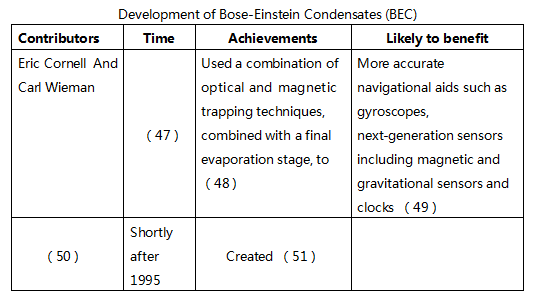英语科技文选自考2009年07月真题及答案解析
-
More accurate navigational aids such as gyroscopes, next-generation sensors including magnetic and gravitational sensors and clocks will all get a boost from the research from the latest physics Nobel Prize winners, who have been supported for years by the Office of Naval Research.
Eric Cornell, Carl Wieman and Wolfgang Ketterle were honored for their creation of Bose-Einstein Condensates (BEC) in gases of atomic rubidium and sodium. Their scientific advances built on the work of Albert Einstein who did the math to show that when cooled, particles called bosons would stop flitting around and settle into a shared low-energy state. The researchers demonstrated this, showing that when cooled thousands and even millions of bosons will act coherently as one, allowing scientists to manipulate the “super-size boson.”
Cornell and Wieman, physicists working at the University of Colorado at Boulder used a combination of optical and magnetic trapping techniques, combined with a final evaporation stage, to coerce about 2,000 cooled rubidium atoms into a BEC in 1995. Shortly there after, Ketterle, working at the Massachusetts Institute of Technology, was able to create an even larger BEC cloud out of sodium atoms using a different technique. BEC allows scientists to create a large group of atoms to show off the wave nature of matter.

-
My View on Cyber Love
-
The passage supports which of the following conclusions?
- A.Contemporary art has been nourished by modern science.
- B.The impacts of modern art and science are actually mutual.
- C.Destruction or break-up has been typical of modern art.
- D.The art’s analysis of our world seems deeper than science’s.
-
The Surrealists made every effort ________.
- A.to transform real existence into incoherent dreams
- B.to diminish all time barriers and moral judgments
- C.to express their disconnected subconscious thoughts
- D.to substitute direct expressions for fragmented images
-
According to the passage, Freud’s studies________.
- A.are less comprehensible than most scientific inventions
- B.are more controversial than any other scientific findings
- C.have imposed much interference upon contemporary arts
- D.have found their expression in the Surrealism’s claims
-
The inventions of new materials and welding techniques________.
- A.are responsible for most of the changes in sculpture arts
- B.enable sculptors to superimpose multiple sides of their designs
- C.permit details of an object to be magnified and seen clearly
- D.provoke artists to make themselves adaptable to the surroundings
-
Which of the following is NOT true according to the last paragraph?
- A.At nanokelvin temperatures, particles bounce off the walls in an ordinary container.
- B.At nanokelvin temperatures, atoms cannot be kept in an ordinary container.
- C.There has never been a container that can be cooled to nanokelvin temperatures.
- D.At nanokelvin temperatures, the magnetic force pushes the atoms away from each other.
-
(B)
Modern technology and science have produced a wealth of new materials and new ways of using old materials. For the artist this means wider opportunities. There is no doubt that the limitations of materials and nature of tools both restrict and shape a man’s work. Observe how the development of plastics and light metals along with new methods of welding has changed the direction of sculpture. Transparent plastic materials allow one to look through an object, to see its vast sides superimposed on each other (as in Cubism or in an X-ray). Today, welding is as prevalent as casting was in the past. This new method encourages open designs, where surrounding and intervening space becomes as important as form itself.
More ambiguous than other scientific inventions familiar to modern artists, but no less influential, are the psychoanalytic studies of Freud and his followers, discoveries that have infiltrated recent art, especially Surrealism. The Surrealists, in their struggle to escape the monotony and frustrations of everyday life, claimed that dreams were the only hope. Turning to the irrational world of their unconscious, they banished all time barriers and moral judgments to combine disconnected dream experiences from the past, present and intervening psychological states. The Surrealists were concerned with overlapping emotions more than with overlapping forms. Their paintings often become segmented capsules of associative experiences. For them, obsessive and often unrelated images replaced the direct emotional messages of Expressionism. They did not need to smash paint and canvas; they went beyond this to smash the whole continuity of logical thought.
There is doubt that contemporary art has taken much from contemporary life. In a period when science has made revolutionary strides, artists in their studios have not been unaware of scientists in their laboratories. But this has rarely been a one-way street. Painters and sculptors, though admittedly influenced by modern science, have also molded and changed our world. If break-up has been a vital part of their expression, it has not always been a symbol of destruction; quite the contrary; it has been used to examine more fully, to penetrate more deeply, to analyze more thoroughly, to change, isolate and make more familiar certain aspects of life that earlier we were apt to neglect. In addition, it sometimes provides rich multiple experiences so organized as not merely to reflect our world, but in fact to interpret it.
It can be learned from the passage that artistic creations________.
- A.can be seen as the reflections, of the material world
- B.seem to be incapable of escaping material advances
- C.are said to have made great strides scientifically
- D.appear to be the reproductions of modern technology
-
According to this passage, the lowest temperature reported so far is________.
- A.three nanokelvin
- B.half-a-billionth of a degree above absolute zero
- C.one microkelvin
- D.one nanokelvin
-
In the ultra-low temperature gas, atoms move ________.
- A.as fast as a plane
- B.as if running a mile under four minutes
- C.at speed of half a minute
- D.one inch for 30 seconds
外贸函电2008年7月真题试题及答案
外贸函电2009年4月真题试题及答案
外贸函电2009年7月真题试题及答案
外贸函电2010年4月真题试题及答案
外贸函电2010年7月真题试题及答案
外贸函电2011年4月真题试题及答案
外贸函电2011年7月真题试题及答案
外贸函电2012年4月真题试题及答案
外贸函电2012年7月真题试题及答案
外贸函电2013年4月真题试题及答案
